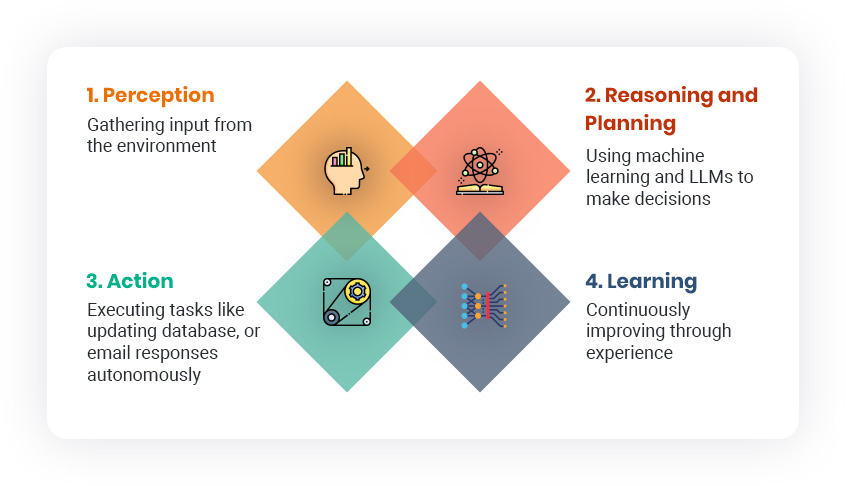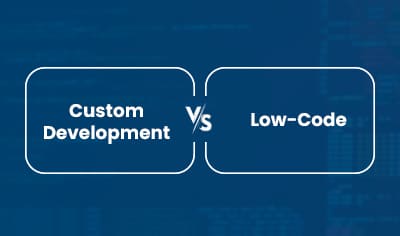Executive Summary
AI agents are the next frontier in enterprise automation, offering autonomous decision-making and task execution capabilities. CIOs and CTOs can leverage them to drive efficiency, cut costs, and boost customer experience with applications across industries ranging from finance to telecom. However, it’s crucial to consider implementation challenges, security, and scalability before adopting AI agents.
Welcome to the age of AI agents. From big names like Microsoft and Salesforce to smaller tech companies, AI agents are making waves, blending AI with decision-making in ways we’ve never seen before.
AI Agents: Beyond LLMs and Chatbots
AI agents offer a new level of automation beyond chatbots and Large Language Models (LLMs). While chatbots handle basic queries and LLMs aid in communication, AI agents autonomously process data, make decisions, and execute tasks — whether it’s updating databases, sending emails, or integrating with systems — all without human input.
How AI Agents Work
AI agents operate through four key functions:

Example: A customer service AI agent at a telecom company autonomously handles a billing inquiry by understanding the request, retrieving the information, and responding to the customer — all without human intervention.
“The combination of AI agents and LLMs is paving the way for new digital transformation opportunities.”
Industry Adoption: Accelerating AI Agent Integration
AI agent adoption has surged across industries. In 2024, McKinsey reported a 72% AI adoption rate, with enterprises increasingly seeking automation for competitive advantage. A recent Forum Ventures survey showed that 48% of companies are already using AI agents, with another 33% exploring solutions.
Decision-Making: Trusting AI with Critical Choices
To assess the reliability of AI agents, it’s essential to understand the reasoning capabilities of Large Language Models (LLMs). LLMs display various types of reasoning, such as:
Deductive Reasoning Applying general rules to specific cases, like deducing that “whales are warm-blooded” because they are mammals.
Inductive Reasoning Drawing broader conclusions from specific examples, such as assuming that “most birds can fly” based on observed instances.
Analogical Reasoning Making connections between similar concepts, like comparing the structure of an atom to a solar system.
Commonsense Reasoning Handling everyday scenarios, like knowing that “ice melts in the sun.”
However, despite their impressive linguistic abilities, LLMs have limitations. They rely on data patterns, which means they don’t truly “understand” concepts like humans do. LLMs can also generate incorrect information, known as hallucinations, and are highly sensitive to how queries are phrased. Additionally, they lack real-time data access and can’t make intentional, goal-driven decisions.
This is where AI agents come in. By integrating LLMs with other technologies, AI agents can overcome many limitations. They can:
Enhance Decision-Making Combine LLMs with rule-based systems and real-time data for more accurate decisions.
Ensure Reliability Implement safeguards and human oversight to maintain reliability and compliance.
Provide Transparency Explain their reasoning and decisions to offer clear transparency.
Improve Continuously Learn from interactions to become more reliable over time.
With built-in safeguards and human oversight, AI agents offer transparency by explaining their actions and continuously learning from interactions. This makes them more reliable over time, allowing for more accurate, autonomous decision-making. Gartner sums it best, “Effectively managing the risks of software entities acting autonomously requires advanced tools and strict guardrails.”
CIO Action Plan
1. Start with Strategy Define how AI agents align with your business goals and identify high-value areas to implement.
2. Invest in Talent Upskill your team to implement and manage AI agents effectively.
3. Focus on Data Quality Ensure robust data management for accurate AI agent performance.
4. Implement Governance Implement frameworks to manage risks and ensure transparency and fairness.
Looking Ahead
The combination of AI agents and LLMs is paving the way for new digital transformation opportunities. With their scalability, advanced decision-making, and expanded functionality, AI agents give CIOs the tools they need to streamline operations and foster innovation, positioning businesses for future success.





